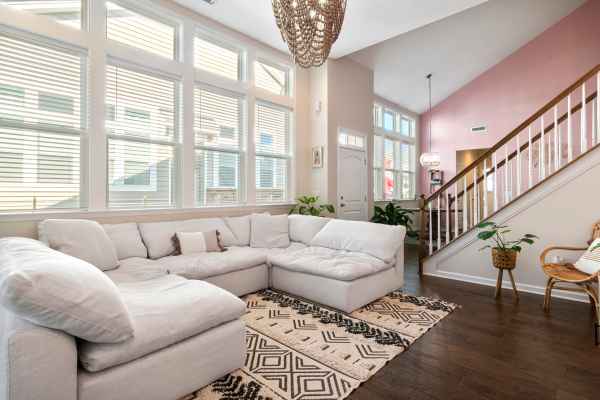Enhancing the aesthetic appeal and functionality of a living room, one crucial aspect that often goes overlooked is the choice of window treatments. This selection is not merely about decorating; it’s about creating a space that reflects your style while addressing needs such as privacy, light control, and energy efficiency. The right window treatments can transform a room, making it more inviting and comfortable for both the inhabitants and guests. This guide aims to shed light on the importance of choosing and Ideas For Living Room Window Treatments and explore the various types available for living rooms.
The Importance of Choosing the Right Window Treatments
Selecting the ideal window treatments for your living room is pivotal for several reasons. Firstly, they play a significant role in controlling the amount of natural light that enters the space, which can affect the room’s ambiance and even your mood. Secondly, window treatment provides much-needed privacy, especially in living areas that face busy streets or neighbors. Furthermore, they can serve as an insulator, keeping the room warmer in the winter and cooler in the summer, which, in turn, can lead to energy savings. Beyond functionality, the aesthetic aspect cannot be understated; the right window treatment can complement the room’s decor, tying together various design elements into a cohesive whole.
Types of Living Room Window Treatments
Curtains

Curtains are perhaps the most traditional and versatile option for living room windows. Available in a myriad of fabrics, patterns, and lengths, curtains can be tailored to fit any decor style, from classic to contemporary. They offer varying degrees of light filtration and privacy, depending on the material chosen, and can add a layer of texture and warmth to the space. For a more dramatic effect, floor-to-ceiling curtains can make the room appear taller, while lighter fabrics can soften the overall look of the living area.
Blinds

Blinds are a practical and stylish option for living room windows, offering precise control over light and privacy. They come in various materials, including wood, faux wood, metal, and plastic, allowing them to fit into any design scheme. Wood and faux wood blinds, in particular, add a warm, natural element to the room, while metal blinds can introduce a sleek, modern touch. The ability to adjust the slats for light control makes blinds a versatile choice for any living room.
Shades

Shades are a clean and efficient window treatment option, available in roller, Roman, cellular, and woven wood styles, among others. They offer a streamlined look by fitting snugly within the window frame and can be easily adjusted to control light and privacy levels. Cellular shades, also known as honeycomb shades, are particularly beneficial for energy efficiency, as their unique design traps air and provides insulation. On the other hand, Roman shades add a touch of elegance and sophistication to the living room, with their soft fabric folds.
Shutters

Shutters are an excellent option for those seeking durability and a timeless look. Whether crafted from wood or composite materials, shutters can add value to your home with their classic appeal and sturdy construction. They fit tightly against the window frame, providing excellent light control and privacy. Moreover, shutters can be painted or stained to match the living room’s decor, making them a highly customizable choice. Their solid presence and architectural detail can enhance the overall character of the space.
Customization Options
The realm of living room window treatments is vast and varied. Offering endless possibilities for customization to fit your specific needs and decor style. Today’s options go beyond mere color and material choices, encompassing a range of mechanisms for opening and closing, as well as varying levels of transparency and thermal properties. Custom-made treatments can be tailored to the exact dimensions of your windows, ensuring a perfect fit that off-the-shelf options cannot match. Furthermore, technological advancements allow for motorized window treatment, which can be adjusted with the simple click of a button or even set to automated schedules, blending convenience with modern sophistication.
Window Treatment Ideas for Different Living Room Styles
Modern

For living rooms boasting a modern aesthetic, the focus is on clean lines and minimalist design. Window treatments in this style often feature sleek, simple shades or blinds made from materials like metal or a refined fabric. Roller shades and solar shades are particularly popular in modern settings. Offering a streamlined look that complements the room’s contemporary furniture and decor. Motorized options enhance this modernity, allowing for effortless control and a clutter-free appearance.
Traditional

Traditional living rooms exude elegance and comfort, calling for window treatment that reflect these qualities. Rich, luxurious curtains in velvet or silk, draped elegantly with tiebacks or tassels. Can add a touch of sophistication and warmth. Wood blinds or shutters in a dark stain can also complement the classic furniture pieces and ornamental details typical of traditional decor, providing a sense of timelessness and durability.
Eclectic

Eclectic living rooms are a blend of various styles, textures, and colors, making the choice of window treatment particularly exciting. This style allows for creative combinations. Such as layering patterned curtains over simple shades or incorporating vibrant colors and unique materials. Eclectic decor benefits from the mix-and-match approach, where contrasting elements are brought together to create a cohesive and personal space. Roman shades in bold prints, paired with sheer curtains, can offer both style and functionality to these vibrant living rooms.
Combining Functionality and Aesthetics
The art of selecting living room window treatments lies in finding the perfect balance between functionality and aesthetics. This means choosing options that not only enhance the room’s decor but also fulfill practical requirements such as privacy, light control, and energy efficiency. Innovative designs and materials allow for window treatment that can act as focal points in the room while simultaneously providing the desired degree of privacy and light filtration. For instance, layered window treatment, combining sheer curtains with heavier blackout drapes, offer versatility and style. They allow natural light during the day while ensuring complete privacy and darkness when needed. All without compromising the room’s overall design theme.
Privacy and Light Control
Privacy and light control are paramount when considering window treatment for your living room. Options like adjustable blinds and shades offer precise control over the amount of light entering the space and can be easily adjusted to block unwanted views. Ensuring a comfortable environment at any time of the day. Materials play a crucial role here; for example, opaque or semi-opaque materials can soften the incoming light and provide privacy without making the room feel closed off. Moreover, directional slats in blinds can direct light away from seating areas or screens, reducing glare and enhancing the room’s usability.
Energy Efficiency
Window treatments can significantly contribute to a living room’s energy efficiency by providing an extra layer of insulation and controlling natural light. During winter, treatments like thermal curtains or honeycomb shades trap heat inside, reducing the need for artificial heating. In summer, reflective blinds or light-colored treatments can deflect sunlight, keeping the room cooler. This not only improves the comfort level of the living space but can also lead to noticeable savings on energy bills by reducing the need for heating and cooling.
Maintenance and Durability
Choosing window treatments, considering their maintenance needs and durability is crucial. Materials that are easy to clean and resist fading will look better and last longer, offering better value over time. For example, synthetic fabrics and composite materials can offer the look of more delicate fabrics or natural wood but are more resistant to sunlight and easier to maintain. Selecting window treatments that balance low maintenance with high durability ensures that your living room will remain stylish and comfortable with minimal effort.
Can Window Treatments Really Help Save on Energy Costs?
Indeed, window treatment can significantly contribute to energy savings within a home. Materials and designs that provide insulation, such as thermal curtains, cellular shades. And certain types of shutters and blinds, are particularly effective. These options work by creating a barrier against heat loss during the winter and minimizing heat entry during the summer, thereby reducing the reliance on heating and cooling systems. Consequently, homeowners can enjoy a more comfortable living environment along with noticeable savings on their energy bills.
How Often Should I Replace My Living Room Window Treatments?
The lifespan of living room window treatments depends on various factors including material quality, exposure to sunlight, and usage. High-quality fabrics and materials can last for over a decade, especially if they are well-maintained. However, style updates or functional needs might prompt a change sooner. On average, considering both wear and tear and changing design trends, window treatment might be replaced every 5 to 8 years. Regular maintenance can extend their lifespan, delaying the need for replacement.
Are There Window Treatments That Are Better for Allergy Sufferers?
Yes, certain window treatments are indeed better suited for individuals suffering from allergies. Roller shades and cellular shades, for instance, are excellent choices as they have smooth surfaces that are easier to clean and less likely to collect dust, pollen, and other allergens. Materials such as synthetic fabrics are preferable over heavy drapes or textured fabrics that can trap allergens. Additionally, shutters made from wood or faux wood can be wiped down regularly, minimizing the accumulation of dust. Choosing window treatments that are hypoallergenic and easy to maintain can significantly reduce allergens in the living room. Creating a healthier environment for allergy sufferers.
Can I Mix and Match Different Types of Window Treatments in One Room?
Mixing and matching different types of window treatment in one room can create a dynamic and customized look. Allowing for flexibility in light control, privacy, and aesthetic appeal. For instance, layering sheer curtains over blinds or shades can offer a soft. Decorative touch while still providing the practical benefits of light filtration and privacy. When combining different window treatment, it’s important to maintain a cohesive look by coordinating colors, textures, and styles that complement the room’s overall decor. This approach allows for a tailored look that meets specific needs and personal tastes.
What’s the Best Way to Measure Window Treatments?
Measuring window treatments accurately is crucial for achieving a perfect fit and the desired look. Begin by determining whether the treatments will be mounted inside or outside the window frame, as this affects the measurements. For the inside mount, measure the width and height of the window frame in three places: the top, middle, and bottom for width, and the left, middle, and right for height. Use the narrowest width and the longest height to ensure the treatment fits within the frame. For the outside mount, measure the width of the area you wish to cover, typically extending beyond the window frame by 3 to 6 inches on each side to minimize light leakage and maximize privacy. The height should include the desired overlap at the top and bottom. Always double-check measurements to ensure accuracy before ordering.
Conclusion
Living room window treatments, there’s a wide range of options catering to different needs. From allergy sufferers to those seeking energy efficiency or a specific aesthetic. Understanding that you can mix and match treatments opens up endless possibilities for customization. Allowing each living room to reflect the homeowner’s unique style and requirements. Accurate measurement and consideration of material and maintenance needs are key to ensuring that your window treatment not only looks great but also offers the practical benefits you desire. With careful selection and proper care, your living room window treatment can enhance the comfort, functionality, and beauty of your space for years to come.
